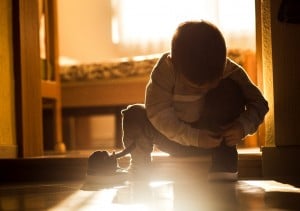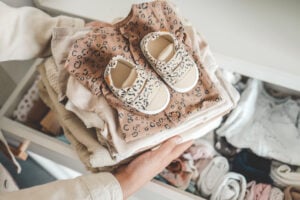We applaud the first roll-over, video the first step, and record the first words, but what about the first time your baby crawls across the floor? This is perhaps the most important developmental milestone and also the most under-appreciated. It is sometimes regarded as a nuisance milestone because the baby is suddenly on the move, and we have to childproof, scrub the floors, and keep the family pet out of the way. But there are many fantastic benefits of crawling for your baby. Once your baby pulls to standing and takes that first step, the opportunity for these benefits is lost forever.4 So, let’s talk about what makes this milestone important!
7 Fantastic Benefits of Crawling
Here are seven reasons why this is an important milestone for your baby:
1. Crawling Strengthens Your Baby’s Trunk Muscles
Think planking for babies. Just as a 30-second plank does wonders for our core (strengthening our abs, back muscles, obliques, shoulders, and hip girdle), crawling does the same for babies. Because babies develop from head to toe and from their trunk outward, a strong core is the foundation for the rest of their strength, coordination, and agility. The weight-bearing through the shoulders and hips builds the strength necessary for good posture and motor skills.1,2
2. Crawling Helps Both Sides of the Brain Work Together
The left side of our brain controls the right side of our body and vice versa.3 So, the two sides of your baby’s brain must learn to work together to have coordinated movement on both sides of the body. The reciprocal action of crawling helps stimulate this and teaches the brain to work together; thereby, the motor skills become more coordinated from left to right.2
3. Crawling Helps the Development of Your Baby’s Visual Skills
Your baby’s vision is still developing throughout the first year when crawling naturally occurs, so their world is still very close to them.5,6 They do not have the 20/20 vision of an adult, and their vision is still developing well past age 4.7 When your baby crawls on the floor, their toys are all within 8-36 inches of their face. This is the field where their vision is most acute and where they can see most clearly. They also gaze at the floor ahead of them while crawling, strengthening the tiny muscles around their eyes and improving their visual-motor skills.8
In addition, crawling helps babies develop binocular vision.9 This is the ability to look ahead in the distance and back down at their hands while crawling.
4. Crawling Strengthens Your Baby’s Hands and Builds Fine Motor Skills
Because your baby is weight-bearing on their hands, the musculature of their hands is strengthened. This means they will have better dexterity for grasping items, coloring, holding a pencil, and eventually writing.2,9 Babies may even hold a small item in their hand while they’re crawling.2
5. Crawling Helps With Their Balance
It takes some skill for your little one to balance on all fours, which is an important building block for walking. Crawling helps your baby’s hip sockets to form. These are important for hip movement, lifting, and strength as they grow and start to walk.4,9
6. Crawling Improves Your Baby’s Spatial Skills
Crawling requires some pretty sophisticated navigating over toys, under chairs, around table legs, and through mommy’s legs. This understanding helps your baby learn about their world and develop body awareness.1,10 It also begins to lay the groundwork for higher-level critical thinking.
7. Crawling Builds Self-Confidence
It can be scary for babies to venture away from mommy and daddy for the first time. But taking these risks will help your baby discover their potential and limitations while they explore their world on their own. For instance, they might learn how to navigate around physical obstacles successfully.9
Crawling doesn’t happen overnight. It is a long process of scooting, creeping, rolling, and eventually pulling those little knees underneath their bodies to propel themselves forward. Encourage crawling! Get down on the floor with your baby, and place toys just out of reach. Some babies will pull themselves to standing and try to go straight to walking, skipping the crawling milestone altogether. But encourage them to get back to all fours. Once your baby masters walking, they will have little time for crawling, and all these great benefits will be missed.4
























